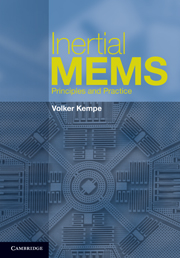4 - MEMS technologies
Published online by Cambridge University Press: 03 May 2011
Summary
MEMS technologies are used for building complete sensor systems including intrinsic sensor elements, transducers, signal-processing blocks, packaging, and testing. Neglecting the interface between the test equipment and the device under test, testing is not ostensibly related to miniaturization. The creation of sensor elements and transducers, however, is based on generic microfabrication technologies, which are exploited to manufacture both integrated circuits and microsystems.
Microsystems, in the broad sense of MEMS, bio-MEMS, microfluidics, optoelectronics (MOEMS), nano-devices and others, have borrowed their basic fabrication steps from IC technologies and extended their use towards micromolding, laser machining, wire electrodischarge machining, diamond milling and other techniques.
The ultimate basis for judging the suitability of microfabrication technologies is economics. Economics is strongly determined by the unit volume and reusability of existing equipment and technology. Even automotive sensors reach, in the best case, multimillion unit sales per year. This number sounds impressive; however, considering a typical yield of some thousand units per wafer, the volume requirement reduces to some thousand wafers per year – a very moderate number for modern wafer fabs. Dedicated fabrication lines would be far too expensive. Common use of basic technologies for industrial ICs and MEMS is the basic paradigm. If they are economically feasible, specialized processing steps like machining of quartz are organized in small and relatively cheap fabrication lines complementing existing technologies.
Generally speaking, a high degree of compatibility of fabrication steps with mainstream microelectronic equipment and technology recipes is decisive for a successful MEMS product and its long-term advancement.
- Type
- Chapter
- Information
- Inertial MEMSPrinciples and Practice, pp. 152 - 204Publisher: Cambridge University PressPrint publication year: 2011



